MLS Commissioner Don Garber paid a visit to the Twin Cities yesterday for a whirlwind tour of all things Minnesota United, making four stops in less than 12 hours. The commissioner was joined by Dan Courtemanche (Executive Vice President of Communications), Charles Altchek (Vice President, Commissioner’s Office) and Saint Paul-native Mark Abbott (President & Deputy Commissioner).
Allianz Field
Garber and his retinue began their day with a tour of Allianz Field. Everyone got changed into safety equipment — work boots, fluorescent yellow vests, hard hats, goggles — at the Mortenson office on Snelling and checked out a wall mural depicting the planned interior of the stadium. An actual piece of the PTFE mesh screen was passed around, with Managing Partner Bill McGuire noting that this will be the first time this kind of covering will be used for a stadium in the world.
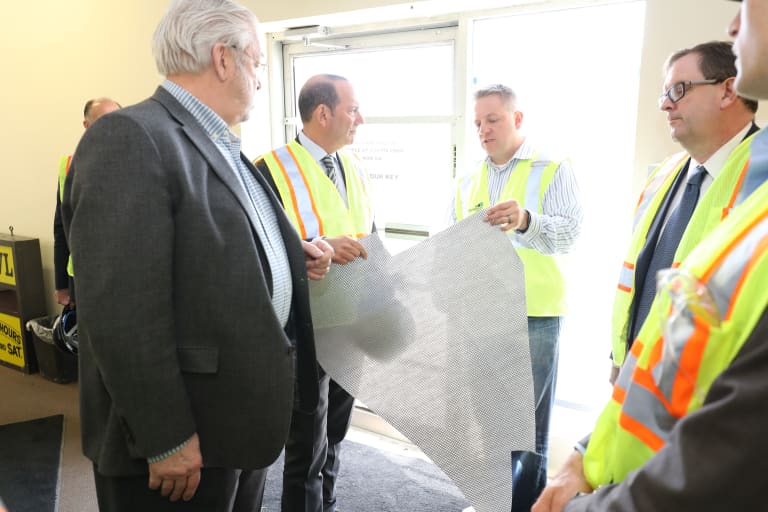
MNUFC CEO Chris Wright talked about the ability to light the façade for any kind of event from purple for Prince’s birthday to red, white and blue for any potential national team matches. Making their way into the bowl of Allianz Field via a tunnel at the southeast corner of the stadium, the group remarked on how far along it was and how impressive it felt, also noting that it would be one of the few stadiums in MLS where the teams come out at midfield as opposed to the corners. After a photo op on the upper level, Garber signed a column in the southwest corner and the group dropped off their safety gear then headed north to Blaine to visit the National Sports Center and check out Minnesota United’s Training Ground.
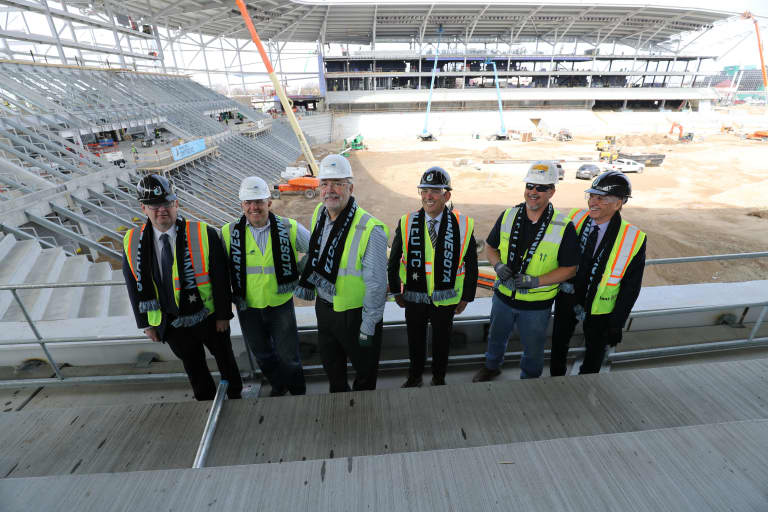
National Sports Center
Up in Blaine, the group met up with Sporting Director Manny Lagos and NSC CEO Todd Johnson and Associate Executive Director Neil Ladd. Garber heard a bit about the public/private partnership that has allowed MNUFC to connect with the community while renovating and improving its training facilities. Minnesota United has built on its existing relationship with NSC to help add two new grass fields and resurface NSC Stadium to create two artificial turf outdoor surfaces to supplement the indoor field. Garber zeroed in on NSC’s four million annual visitors and how they’re working to capture data from those people to help drive the growth of both MLS and soccer in general in the market.
They also toured MLS’ National Sales Center, where salespeople are trained to work in MLS. The center turns out about 75 to 100 salespeople a year with a hiring rate of about 80% and high retention of those graduates within the league versus non-graduates.
The group took a spin through the team’s recently renovated locker room and training area, with several comments about how favorably the facilities compared to what they see in general around the league.
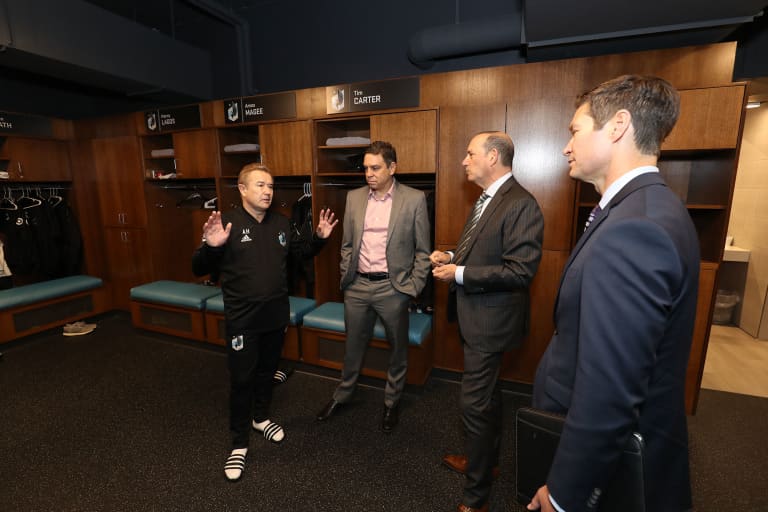
Garber then took some time to meet with members of the media and talk to Minnesota United’s own Callum Williams. He touched on his visit to Allianz Field and his sense that two of the most important things for new stadiums are design and fan engagement and that Allianz Field would deliver on both these fronts. He also touted MLS’ fanbase as the youngest and most diverse in pro sports and emphasized that while the Twin Cities are obviously a busy sports market with the Twins, Vikings, Wild, Timberwolves and Lynx plus college sports to compete against, MLS’ fan crossover from those sports is less than five percent. That means the league is squarely in the business of making new fans, not trying to convert fans.
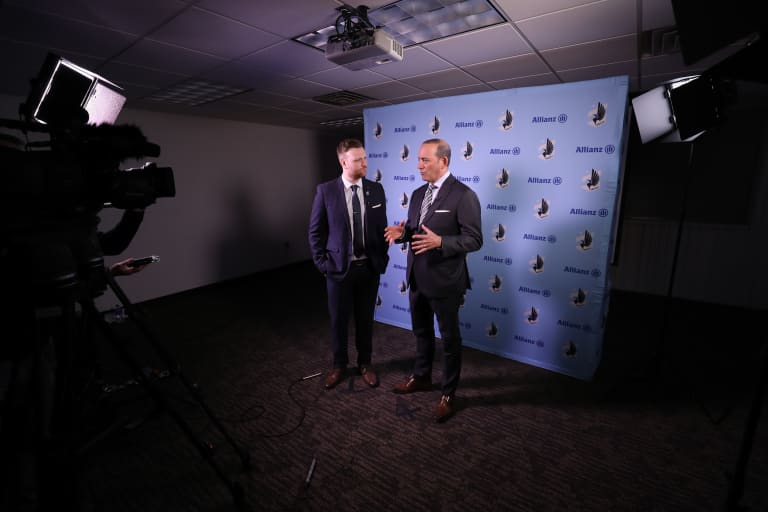
After lunch with Head Coach Adrian Heath and the rest of the coaching staff, it was off to the front office in Golden Valley to meet with the staff.
Minnesota United Front Office
Garber and company’s trip to the MNUFC offices began with a tour of the Experience Center, powered by Atomic Data. Garber got to take in what hundreds of fans have already gotten to experience and came away impressed. At the end of the intro video that closes with fans singing “Wonderwall,” he remarked simply, “Chills.” He was also quite taken with the hologram technology that could show how all of Allianz Field can fit into the lower bowl of TCF Bank Stadium and the touchscreen technology that allows fans to check out the view from any seat in Allianz Field.
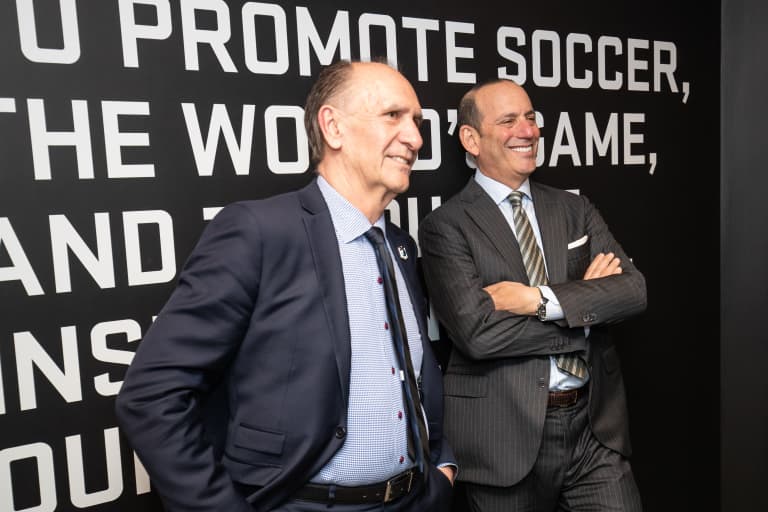
Garber then addressed the entire staff, touching on how he feels the best days of the sports industry are ahead of it and how it’s become a leading-edge industry for things like data gathering and implementation. He also spoke about the power of sports to be a positive influence on lives in the community and how Minnesota United’s core values line up so well with MLS’ own values and those of many teams around the league. He took some questions from the assembled and then closed out the meeting with a #ScarvesUp photo with the entire staff.
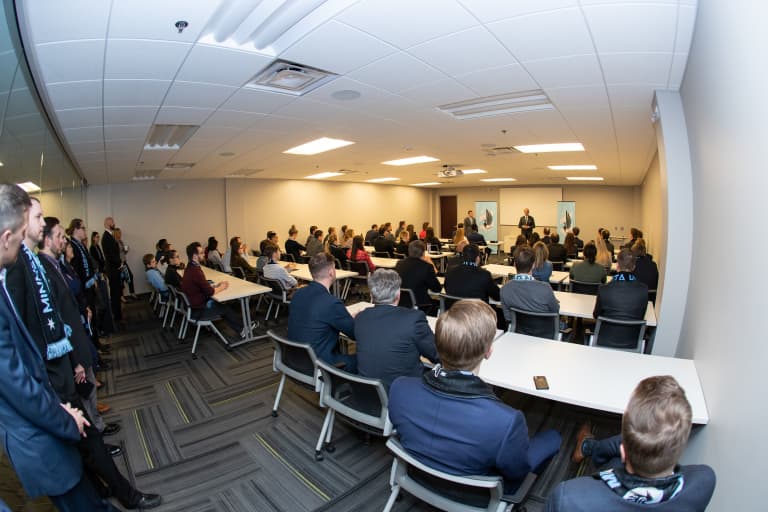
Next, it was on to BlackStack Brewing to finish the day with an event for supporters.
BlackStack Brewing
At BlackStack, a hearty group of serious fans wearing jerseys from just about every era of pro soccer in Minnesota gathered to hear from Garber, who was hosted on stage by the Loons’ broadcast crew of Callum Williams and Kyndra de St. Aubin with Jamie Watson out in the crowd with a microphone for questions. Although he touched on many of the things he’d mentioned to others earlier in the day, he ranged further here than before. He talked about his experience with the at-the-time small Empire Supporters Club early on at a MetroStars game and how he felt if you could grow that kind of support, you’d have an authentic soccer experience. He spoke about the fierce undercurrent of belief in soccer that’s existed in the U.S. for a long time but that has taken a long time to grow to the point where it could genuinely support the sport.
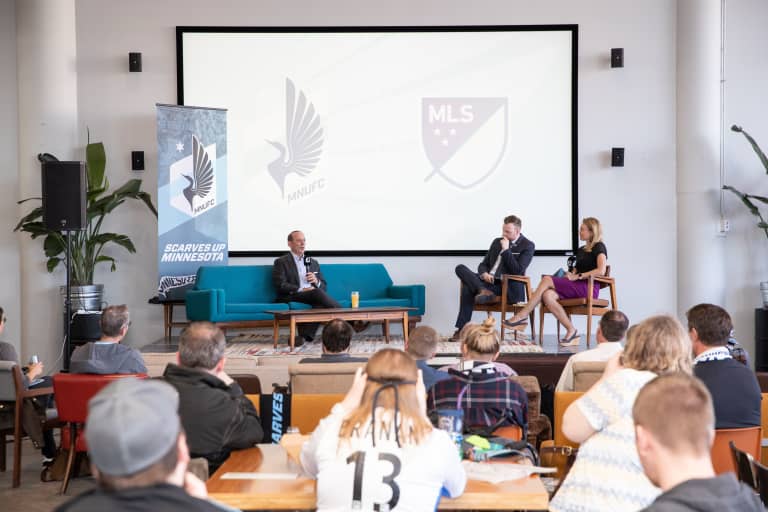
There have been challenges and missteps in growing the game, he acknowledged. Early on, the thought was the league needed big stadiums to compete on a level playing field with the other major sports, but then that thinking shifted toward building complexes with multiple uses. That was followed by a growth in the number of urban stadiums that would integrate into surrounding neighborhoods, but also ultimately a recognition that different markets simply had different profiles and demands. He also admitted that he was against adding another "United" team when MNUFC was joining, but has now seen what a great brand it is and that he was wrong.
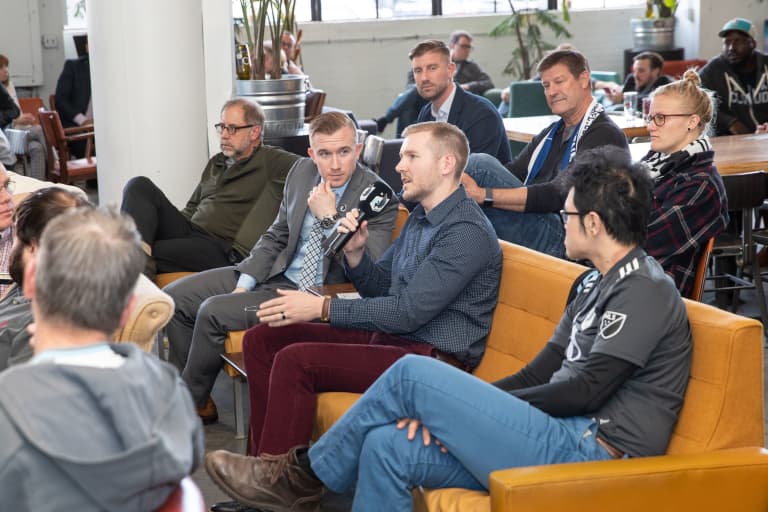
He addressed questions from longtime fans about how work at MLS was progressing on a clear disciplinary policy for supporters, on the possibilities for realignment — which Garber said would have to wait for more clubs to come into the league — and also how the league went about evaluating potential markets for expansion. On that last point, Garber said that the success of teams like Atlanta United had gone a long way toward making the league reconsider how they evaluate expansion, given that soccer had little to no history in the market and yet they’ve obviously been a smashing success. Their thinking now is that MLS can be successful anywhere given three essential elements: local ownership, engaged key executives and the right stadium located in the right place.
Garber and the rest of the delegation from MLS wrapped up their visit with a reception at the Hewing Hotel in Minneapolis’ North Loop before heading back to the airport and home to New York.





